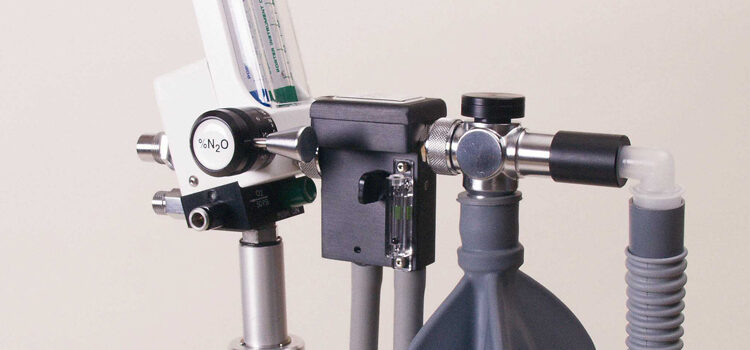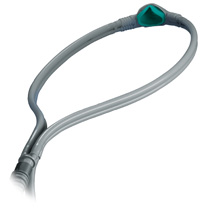
Getting Serious About Laughing Gas
John A. Yagiela, DDS, PhD, shares his expertise on the administration of nitrous oxide and its effects on the practitioner and the patient.
Q: Why is nitrous oxide so commonly used in dentistry?
A: Nitrous oxide is a great agent because it relieves anxiety and also has specific actions that relieve discomfort. Plus, once patients quit breathing the gas, the effects dissipate very quickly so they can drive themselves home from the dental appointment. Nitrous oxide has significant advantages when dealing with the minor discomfort that’s relatively common with deep scaling. Nitrous oxide has been used for many decades in general anesthesia because of its analgesic properties. It has a morphine-like effect—while it doesn’t eliminate discomfort, it mutes it, and it removes the emotional content of pain. A patient might respond when asked if something hurts with, “Yes, it just doesn’t bother me.” Some drugs, like barbiturates, have the opposite effect. They relieve anxiety but may intensify reactions to a painful stimulus.
Q: Does nitrous oxide have any contraindications?
A: First of all, nitrous oxide is a gas that moves throughout the body relatively quickly. If there is any gas-filled space in the body, nitrous oxide tends to accumulate there and increase pressure. This increase in pressure may be harmful for people with conditions such as bowel obstruction or tension pneumothorax. In these patients, nitrous oxide can expand the air cavity and even burst the intestine or collapse the lung. But these problems are generally seen in hospital-bound patients, not in dental patients.
 A related example of a patient who might walk into a dental office is someone with a blocked Eustachian tube, which may leave gas trapped in the middle ear. If given nitrous oxide, this patient may experience ear pain because of increased pressure in the middle ear. Another possibility is a patient who has undergone vitreo-retinal surgery. Patients with surgery in the posterior chamber of the eye may have gas injected into the eyeball to keep it stable. If nitrous oxide is administered, it may expand the gas bubble and possibly cause blindness. These patients shouldn’t receive nitrous oxide or fly for up to 3 months after their surgery.
A related example of a patient who might walk into a dental office is someone with a blocked Eustachian tube, which may leave gas trapped in the middle ear. If given nitrous oxide, this patient may experience ear pain because of increased pressure in the middle ear. Another possibility is a patient who has undergone vitreo-retinal surgery. Patients with surgery in the posterior chamber of the eye may have gas injected into the eyeball to keep it stable. If nitrous oxide is administered, it may expand the gas bubble and possibly cause blindness. These patients shouldn’t receive nitrous oxide or fly for up to 3 months after their surgery.
Q: Is this a concern for patients who have undergone lasik eye surgery?
A: No, lasik surgery is not a problem. The concern arises when the eyeball itself has undergone surgical invasion and gas injection.
Q: Are there risks for dental hygienists administering or working around nitrous oxide?
A: I think the risks are somewhat overstated, but there are data indicating that if a woman is working in the dental office and is chronically exposed to nitrous oxide in an unscavenged environment, there’s a potential for decreased fertility. There are also concerns about miscarriage, birth defects, and other health problems, but the one that has the strongest support in the literature is decreased fertility.
Women working in a dental office that uses nitrous oxide should insist on an effective scavenger device. The device that was developed in conjunction with the National Institute of Occupational Safety and Health (NIOSH), currently called the Porter Brown mask, has the best evidence for efficacy. The Porter Brown nasal hood is a mask within a mask. The nitrous oxide is delivered through the inner mask. The exhaled gas and gas that leaks around the inner mask are removed by the outer mask. The most common nasal hoods I see in the dental office do not have this mask-within-a-mask feature. They are usually a single mask with a suction device to take out exhaled gas and perhaps some of the surrounding air, but these types are not as effective as the Porter Brown mask in reducing occupational exposure.
Q: How much should the volume be turned up on the scavenger?
A: You should follow the manufacturer’s instructions. Other issues are also important, such as where the gas is being exhausted. If the high-speed suction is vented effectively to the outside environment, this is perfect. Unfortunately, some systems are designed so the contaminated air is transported right back into the office. The American Dental Association has guidelines on using nitrous oxide safely.
Q: What happens with chronic exposure to nitrous oxide?
A: Nitrous oxide oxidizes the cobalt atom of vitamin B12 bound to the enzyme methionine synthase. This enzyme, which produces both methionine and tetrahydrofolate, is critical for the synthesis of DNA and the myelination of nerves. As a result of excessive nitrous oxide exposure, the enzyme becomes permanently inactivated, and a new enzyme must be synthesized.
Methionine synthase is quite susceptible to inactivation by nitrous oxide. Chronic exposure to low concentrations of nitrous oxide can, over time, produce significant losses of methionine synthase activity. But losses can also occur if you breathe a high concentration for a shorter period of time. For example, when a patient is given 30% nitrous oxide for 3 hours, he or she loses half of the enzyme, which then must be replaced. Most people can tolerate this fine so long as they are exposed to the gas less than once a week. It can become a major health problem, however, when nitrous oxide is self-administered more frequently than that by the dentist, dental hygienist, or office staff. There is also concern that people with severe defects in folic acid metabolism may be unusually susceptible to this action of nitrous oxide. Because patients with autism may have a higher than normal incidence of folate metabolism abnormality, some parents are now concerned that nitrous oxide may not be good for their autistic children. Data are not available on this issue, but it is one that dentistry will have to address.
Q: Can patients develop a tolerance to nitrous oxide making it less effective?
A: If nitrous oxide is administered less frequently than once a week, there is no true development of tolerance between appointments. What may happen is that patients have become comfortable with the gas, and they may want to have a stronger effect at subsequent visits. Acute tolerance actually can develop during a single administration, especially with regard to the analgesic effect of the gas.
There are also “resistant” people who do not respond well to nitrous oxide. They simply don’t get the euphoria it usually produces, or the effects scare them because they feel like they’re losing control. I don’t know if there is any scientific basis to it, but I have noticed that people who get tingles in their fingers and toes as the gas is being inhaled overwhelmingly respond positively. On the other hand, people who don’t experience tingles but feel pushed down in the chair by nitrous are less likely to have a positive outcome.

Q: Tell us about the possibility of abuse, like patients who continually want higher levels.
A: They probably like the effect of the gas. I wouldn’t necessarily call this abuse, they just really like the effect and they want more of it. Abuse to me, is more of a drug-seeking behavior outside of the therapeutic setting, and not a single use, but repeated use on a regular basis. Because patients don’t have as ready access to nitrous oxide as do health care workers, particularly dental personnel, abuse is not that common. The biggest concern about abuse involves dental personnel.
Q: Can nitrous oxide abuse kill?
A: Yes, deaths have occurred most often because people have self-administered extremely high concentrations while they are alone. Then, either because they throw up and aspirate or for some other reason lose their airway, they asphyxiate. Also, a big problem with chronic abuse is the neurologic damage, which may be permanent or only partially reversible. Some individuals have committed suicide because of the grave motor deficits that accompanied this damage.
Q: How should the patient who wants more and more of nitrous be treated?
A: First of all, it’s laughing gas so it makes you euphoric. If patients want to have a little more, and they’re staying fully cogent, you can probably increase it a small amount.
 Q: What if a patient falls asleep after receiving it?
Q: What if a patient falls asleep after receiving it?
A: There are some dental patients who fall asleep just by sitting in the chair for some time. Also, local anesthetics are sedative in nature, and after they’re absorbed, they may help promote sleep. Nitrous oxide is, of course, an anxiety reliever, which may relax the patient to the point of sleep. As long as patients are easily awakened by asking them to open their eyes, with or without a light touch, that’s acceptable. But if they fall asleep and cannot be easily aroused, then they are too deep and you need to reduce the nitrous oxide concentration immediately.
Q: What about the combined use of topical and injectable local anesthetics with nitrous oxide?
A: Nitrous oxide is commonly administered with both forms of local anesthetics. Although nitrous oxide has specific analgesic properties, additional pain control is generally needed for restorative dentistry and is often useful for deep scaling. An advantage of the combination is that the nitrous oxide, by its analgesic effect and because it alleviates anxiety, helps the local anesthetic work better. There are no specific contraindications to the combined use of these agents. Although there are potentially additive sedative effects with these agents, there is no need to adjust local anesthetic dosages. If a patient starts to get too sleepy, simply reduce the concentration of nitrous oxide accordingly.
From Dimensions of Dental Hygiene. January 2008;6(1): 26, 28, 30.

